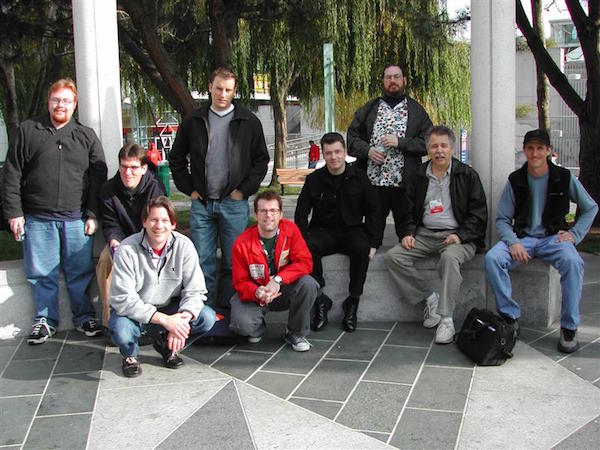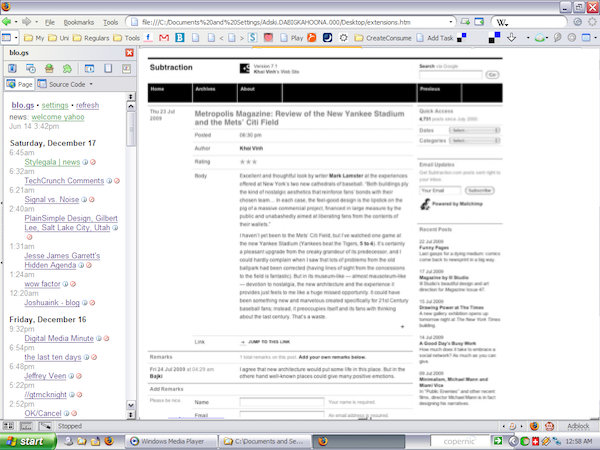The best of the indie web
Oct 22, 2014

Today I was thinking about the recent resurgence of the “indie web” — the notion that instead of posting all our daily writing into corporate silos with bad APIs and zero export options, maybe we should go back to independent blogs and voices on our own servers, with some sort of glue-code in between. That made me think back to posting 4–5 times a day on my own blog, and RSS (and The Time Before Google Reader Was Killed), and even back before that. I tried to think of the ultimate time for the indie web, when I was experiencing my favorite setup during the early days.

From about 2002 to about 2005, I feel like I was enjoying my favorite time on the web, a “golden age” for independent content if you will. My setup wasn’t based on RSS but instead on the ping service blo.gs. You could add a sidebar to your browser that listed all your favorite sites in the order in which they were updated, so when you had time to kill, a few times a day you’d load it up and hit the first 3–4 sites, read their most recent updates, and enjoy it in each site’s full design. Back then, most of the blogs I followed were written by web designers, so I felt it was important to see their content as they intended in their site’s own design, which would periodically undergo redesigns, which used to be a big thing. I avoided RSS until the blo.gs server got bought by Yahoo and stopped functioning soon after, mostly because I didn’t like content robbed of its design.
It reminds me a lot of the Tilde club’s recently updated list, and how I scan it a couple times a day looking for familiar usernames, and how on Twitter the other day I was suggesting to Anthony that I wished I could build a list of my favorite tilde sites sorted by last update, which is essentially asking for a tilde version of blo.gs. I bet someone could build that in a day with current tools and technology.
Solving Mainstream Problems
A big criticism of Silicon Valley these days is that companies and developers are mostly solving niche problems for a small number of people instead of aiming at the mainstream. And like some sort of laundry or snail mail pickup service would be a killer app for a 24 year old programmer who is busy working at Facebook all day, but would be largely overpriced and unnecessary for someone living in a rural community, even ten years ago I’d say those of us helping shape what the blogosphere looked like and how it functioned suffered from the same problem.
Take my Golden Age above. It required first adding a weird ping service to your blog to notify it whenever you updated, and thousands of people runing blogs had to do the same. Next, you would use bookmarklets to add blogs you read in your browser to your account at blo.gs. After you had a list going, you’d have to then install a browser extension/hack to get a permanent sidebar, and then you could read your favorite blogs as they updated. Also, there was no central service to suggest new blogs to follow, so you kind of had to surf around to find any to get started using the service.
I’d say Myspace was a close mainstream approximation of my Golden Age of blogs described above. Myspace let people blog, showed your friends list in the order of recent updates, and let users customize their pages to often hideous (yet very personalized) degrees. It didn’t require bookmarklets or customizing your browser, and you didn’t need to be a web designer that could install server software that also wrote daily. It brought the same kind of world I enjoyed to a much larger audience.
Obviously, Twitter and Facebook very much followed Myspace and took away the quirky custom designs and differentiation and instead moved everything to a more predictable and easier to digest feed. This allowed writing and (micro) blogging for the mainstream on an order of magnitude bigger scale than Myspace ever did. The move to reading timelines also reminds me of the “River of News” RSS early apps that I didn’t much enjoy since they robbed each blog of its original design (though I relented and went all-in to RSS around 2005).
Anyway, I really miss blo.gs and would love to see that kind of service come back to tilde.club.